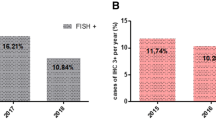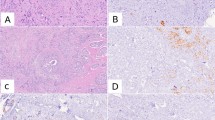Abstract
Expression of the ER and PR receptors is routinely quantified in breast cancer as a predictive marker of response to hormonal therapy. Accurate determination of ER and PR status is critical to the optimal selection of patients for targeted therapy. The existence of an ER−/PR+ subtype is controversial, with debate centred on whether this represents a true phenotype or a technical artefact on immunohistochemistry (IHC). The aim of this study was to investigate the true incidence and clinico-pathological features of ER−/PR+ breast cancers in a tertiary referral symptomatic breast unit. Clinico-pathological data were collected on invasive breast cancers diagnosed between 1995 and 2005. IHC for ER and PR receptors was repeated on all cases which were ER−/PR+, with the same paraffin block used for the initial diagnostic testing. Concordance between the diagnostic and repeat IHC was determined using validated testing. Complete data, including ER and PR status were available for 697 patients diagnosed during the study period. On diagnostic IHC, the immunophenotype of the breast tumours was: ER+/PR+ in 396 (57%), ER−/PR- in 157 (23%), ER+/PR- in 88 (12%) and ER−/PR+ in 56 (8.6%) patients. On repeat IHC of 48/56 ER−/PR+ tumours 45.8% were ER+/PR+, 6% were ER+/PR- and 43.7% were ER−/PR- None of the cases were confirmed to be ER−/PR+. The ER−/PR+ phenotypic breast cancer is likely to be the result of technical artefact. Prompt reassessment of patients originally assigned to this subtype who re-present with symptoms should be considered to ensure appropriate clinical management.
Similar content being viewed by others
References
Anderson WF, Chatterjee N, Ershler WB et al (2002) Estrogen receptor breast cancer phenotypes in the surveillance, epidemiology, and end results database. Breast Cancer Res Treat 76:27–36
Nadji M, Gomez-Fernandez C, Ganjei-Azar P et al (2005) Immunohistochemistry of estrogen and progesterone receptors reconsidered: experience with 5,993 breast cancers. Am J Clin Pathol 123:21–27
Early Breast Cancer Trialists’ Collaborative Group (2011) Relevance of breast cancer hormone receptors and other factors to the efficacy of adjuvant tamoxifen: patient-level meta-analysis of randomised trials. Lancet 378(9793):771–784
Ng CH, Pathy NB, Taib NA, Mun KS, Rhodes A, Yip CH (2012) The estrogen receptor negative-progesterone receptor positive breast carcinoma is a biological entity and not a technical artifact. Asian Pac J Cancer Prev 13(4):1111–1113
Maleki Z, Shariat S, Mokri M, Atri M (2012) ER-negative /PR-positive breast carcinomas or technical artifacts in immunohistochemistry? Arch Iran Med 15(6):366–369
Hammond ME, Hayes DF, Dowsett M, Allred DC, Hagerty KL et al (2010) American Society of Clinical Oncology/College of American Pathologists guideline recommendations for immunohistochemical testing of estrogen and progesterone receptors in breast cancer. J Clin Oncol 28(16):2784–2795
Rakha EA, El-Sayed ME, Green AR, Paish EC, Powe DG, Gee J et al (2007) Biologic and clinical characteristics of breast cancer with single hormone receptor positive phenotype. J Clin Oncol 25(30):4772–4778
De Maeyer L, Van Limbergen E, De Nys K, Moerman P, Pochet N, Hendrickx W et al (2008) Does Estrogen receptor-negative/progesterone receptor-positive breast carcinoma exist? J Clin Oncol 26(2):335–336
Colditz GA, Rosner BA, Chen WY, Holmes MD, Hankinson SE (2004) Risk factors for breast cancer according to estrogen and progesterone receptor status. JNCI J Natl Cancer Inst 96(3):218–228
Yu KD, Di GH, Wu J, Lu JS, Shen KW, Lu GY et al (2008) Breast cancer patients with estrogen receptor-negative/progesterone receptor-positive tumors: being younger and getting less benefit from adjuvant tamoxifen treatment. J Cancer Res Clin Oncol 134(12):1347–1354
Kiani J, Khan A, Khawar H, Shuaib F, Pervez S (2006) ER-alpha negative and PR-positive breast cancer: lab error or clinical entity? Pathol Oncol Res 12(4):223–227
Shen T, Brandwein Gensler M, Hameed O, Siegal GP, Wei S (2015) Characterization of estrogen receptor–negative/progesterone receptor–positive breast cancer. Hum Pathol 46(11):1776–1784
Dunwald LK, Rossing MA, Li CI (2007) Hormone receptor status, tumor characteristics, and prognosis: a prospective cohort of breast cancer patients. Breast Cancer Res 9(1):R6
Rhodes A, Jasani B, Balaton AJ, Barnes DM, Miller KD (2000) Frequency of oestrogen and progesterone receptor positivity by immunohistochemical analysis in 7016 breast carcinomas: correlation with patient age, assay sensitivity, threshold value, and mammographic screening. J Clin Pathol 53:688–696
Gown AM (2008) Current issues in ER and HER2 testing by IHC in breast cancer. Mod Pathol 21(Suppl 2):S8–15
Schnitt SJ (2006) Estrogen receptor testing of breast cancer in current clinical practice: What’s the question? J Clin Oncol 24(12):1797–1799
Goldstein NS, Ferkowicz M, Odish E et al (2003) Minimum formalin fixation time for consistent estrogen receptor immunohistochemical staining of invasive breast carcinoma. Am J Clin Pathol 120:86–92
Williams JH, Mepham BL, Wright DH (1997) Tissue preparation for immunocytochemistry. J Clin Pathol 50:422–428
van Diest PJ, van Dam P, Henzen-Longmans SC et al (1997) A scoring system for immunohistochemical staining: consensus report of the task force for basic research EORTC-GCCG. J Clin Pathol 50:801–804
Larsson LI (1993) Tissue preparation methods for light microscopic immunohistochemistry. Appl Immunohistochem 1:2–16
Rhodes A, Jasani B, Balaton AJ, Barnes DM, Anderson E, Bobrow LG et al (2001) Study of interlaboratory reliability and reproducibility of estrogen andprogesterone receptor assays in Europe. Documentation of poor reliability and identification of insufficient microwave antigen retrieval time as a major contributory element of unreliable assays. Am J Clin Pathol 115(1):44–58
Harvey JM, Clark GM, Osborne CK, Allred DC (1999) Estrogen Receptor Status by Immunohistochemistry Is Superior to the Ligand-Binding Assay for Predicting Response to Adjuvant Endocrine Therapy in Breast Cancer. J Clin Oncol 17(5):1474–1481
Chan M, Chang MC, Gonzalez R, Lategan B, del Barco E, Vera-Badillo F et al (2015) Outcomes of estrogen receptor negative and progesterone receptor positive breast cancer. PLoS One 10(7):e0132449
Hefti MM, Hu R, Knoblauch NW, Collins LC, Haibe-Kains B, Tamimi RM, Beck AH (2013) Estrogen receptor negative/progesterone receptor positive breast cancer is not a reproducible subtype. Breast Cancer Res 15(4):R68
Author information
Authors and Affiliations
Corresponding author
Ethics declarations
Conflict of Interest
The authors have no conflicts of interest to declare.
Rights and permissions
About this article
Cite this article
Foley, N.M., Coll, J.M., Lowery, A.J. et al. Re-Appraisal of Estrogen Receptor Negative/Progesterone Receptor Positive (ER−/PR+) Breast Cancer Phenotype: True Subtype or Technical Artefact?. Pathol. Oncol. Res. 24, 881–884 (2018). https://doi.org/10.1007/s12253-017-0304-5
Received:
Accepted:
Published:
Issue Date:
DOI: https://doi.org/10.1007/s12253-017-0304-5




